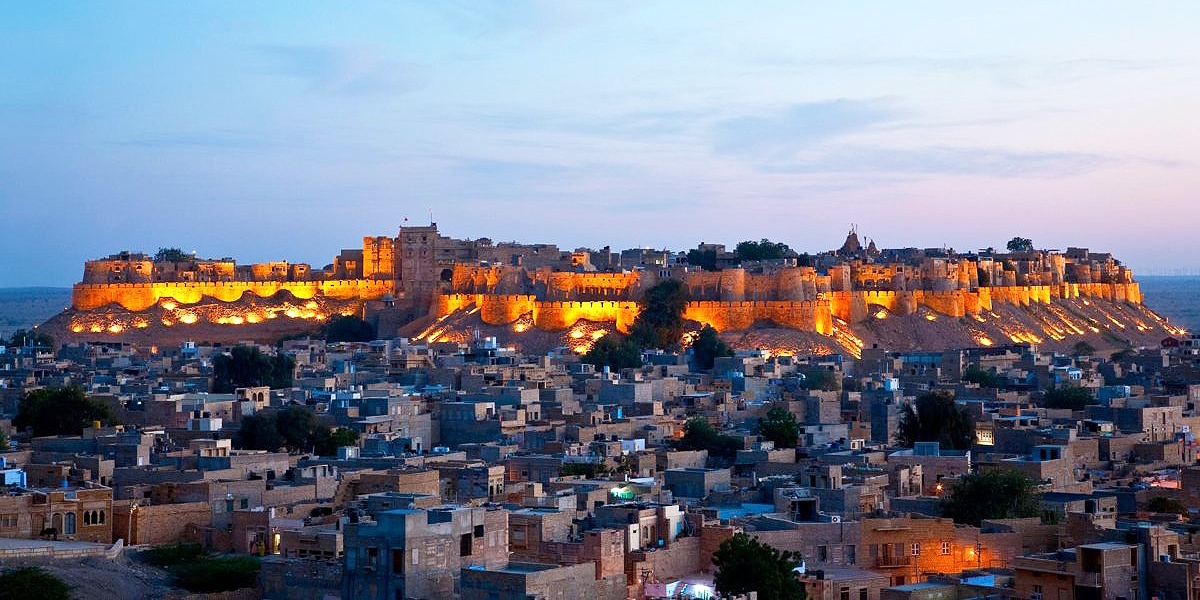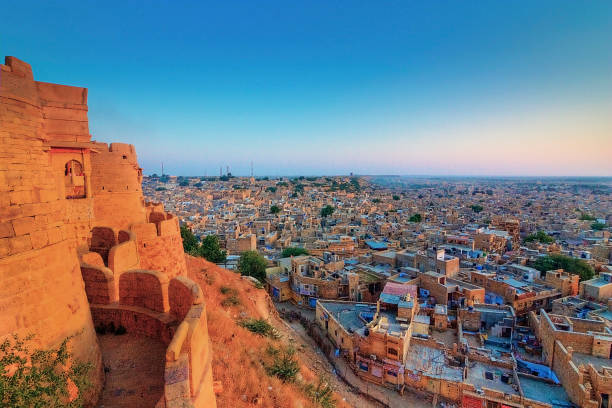Golden Fort in Jaisalmer
More popularly known as the Golden Fort or Sonar Quila, Jaisalmer Fort is the epitome of architectural brilliance. The fort symbolizes the strength of the Rajputs in the bygone era.

Built in 1156 AD, the Jaisalmer Fort has the distinction of being the second oldest fort in Rajasthan after Chittorgarh. Perched atop the Trikuta Hill in Jaisalmer, this grand fort is the proud reminder of a glorious era in Rajasthan's history. Also known as 'Sonar Quila' (Golden Fort) the Jaisalmer Fort is a sight to behold when the rays of the setting sun bathe it in a golden hue. In fact, the effect is so beautiful that visitors are left spell bounded.
Apart from being a military structure, the Jaisalmer Fort is also known for its beautifully designed archways, passages, sandstone facades and lavishly decorated walls. The fort has an old worldly charm about it that draws hordes of visitors every day. No wonder it is also one of the most visited tourist attractions in Jaisalmer. Do make it a point to visit this magnificent relic of the past that would surely leave you enthralled.
This ancient fort in Rajasthan dates back to the twelfth century built for the main purpose to give protection to the people of the city of Jaisalmer. The founder of the fort is Bhati Rao Jaisal which is how it got its name ‘Jaisalmer Fort’.
A visitor can also see several women and kids walking around especially carrying pots filled with milk. This gives a look into the living culture of the local people of Jaisalmer. This great fortress was officially declared as UNESCO World Heritage Site in the year 2013.
There is great historical significance of Jaisalmer Fort. During the medieval times, the route was an important way for trade from various countries and continents. Arabia, Egypt, Persia, Africa and others were included. King Alauddin Khijli overtook the fort and ruled for nearly a decade long before Humayun took over the city of Jaisalmer. It is here that the Rani Padmavati did a Jauhar in order to escape the defeat of the invasion in the thirteenth century.
The view of the Sonar Quila in different times of the day is an amazing thing for tourists and archaeologists, students etc. The sprawling structure is made from exquisite yellow sandstone that attracts a lot of visitors throughout the year. Spread across an area of 5.1 sq. km. at an altitude of 225 meters, there are several inside forts to look out for. Here is an overview of the structures within the fort.
The highlight of the amazing structure is the three – layered walls. The outermost layer consists of stone and the wall is made of such blocks. The middle layer is famous for its length as it defends the whole kingdom inside it. The third is the wall of defense for the soldiers to fight with the enemies.
It is the second largest fort in Rajasthan and is located at an altitude of about 250 meters on top of a hill.
It is a UNESCO World Heritage Site due to its prominent architecture and the importance it had during the course of history.
The structure is a fortification consisting of three layers, with the outermost being made totally out of stone as it was the first layer of protection against enemies.
It has a total of 99 bastions with almost 93 of them being constructed at a later point in history at around 1638 AD.
A novel, Sonar Kella, and a consecutive movie was made with this location as the prime spot by the renowned novelist Satyajit Ray. This led to the spread of the fame of this site.
Alauddin Khilji attacked the Fort and gained control over it for a period of almost 9 years.
It has a blend of both the Rajput and Mughal style of architecture.
This fort can be accessed by the four entrances with one of them having cannons in front of them.
An intricate drainage system called the ‘Ghut Nali’ was designed for allowing proper disposal of drainage from the Fort area.
October to March is the best time as summer is too hot and monsoon gets wet.
